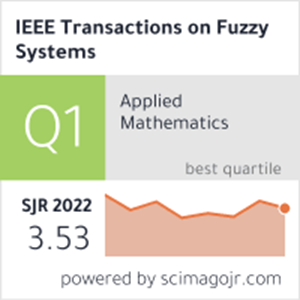A Distributionally Robust Fuzzy Optimization Approach for Resilient Manufacturing Supply Chain Network Design: An RCEP Perspective
IF 11.9
1区 计算机科学
Q1 COMPUTER SCIENCE, ARTIFICIAL INTELLIGENCE
引用次数: 0
Abstract
Recent changes in trade barriers and increasing uncertainties in trade policies have forced companies to rethink their optimal supply chain settings. This article studies the impact of the regional comprehensive economic partnership (RCEP) agreement, particularly the cumulative rules of origin, on the resilient manufacturing supply chain network design problem with demand uncertainty. Three resilience strategies, namely, multiple sourcing, capacity redundancy, and technology innovation, are employed to improve supply chain resilience. Using type-2 fuzzy theory, we develop a distributionally robust fuzzy optimization (DRFO) model to address the proposed problem. In this model, the demand is represented as a parametric interval-valued fuzzy variable and its associated uncertainty distribution set. In terms of the model's tractability, we analyze the computational issues of the credibility constraint and reformulate the DRFO model into a computationally tractable mixed-integer linear program. Finally, we apply the proposed model to a real-life automotive supply chain case and demonstrate its superiority in providing uncertainty-immunized solutions. Our analysis reveals that the RCEP agreement may deepen the manufacturing supply chain networks in Asia–Pacific and promote their integration and localization. Also, we find that using any resilience strategy or a mixture of them can increase supply chain's resilient performance while decreasing costs against disruptions.用于弹性制造供应链网络设计的分布稳健模糊优化方法:RCEP 视角
近期贸易壁垒的变化和贸易政策不确定性的增加迫使企业重新思考其最佳供应链设置。本文研究了区域全面经济伙伴关系协定(RCEP),特别是累积原产地规则,对具有需求不确定性的弹性制造业供应链网络设计问题的影响。本文采用了三种弹性策略,即多重采购、产能冗余和技术创新,以提高供应链的弹性。利用 2 型模糊理论,我们开发了分布式鲁棒模糊优化(DRFO)模型来解决提出的问题。在该模型中,需求被表示为参数区间值模糊变量及其相关的不确定性分布集。在模型的可计算性方面,我们分析了可信度约束的计算问题,并将 DRFO 模型重新表述为一个可计算的混合整数线性程序。最后,我们将提出的模型应用于现实生活中的汽车供应链案例,并证明了该模型在提供不确定性免疫解决方案方面的优越性。我们的分析表明,RCEP 协议可以深化亚太地区的制造业供应链网络,促进其一体化和本地化。此外,我们还发现,使用任何弹性策略或混合使用这些策略,都能提高供应链的弹性性能,同时降低应对中断的成本。
本文章由计算机程序翻译,如有差异,请以英文原文为准。
求助全文
约1分钟内获得全文
求助全文
来源期刊

IEEE Transactions on Fuzzy Systems
工程技术-工程:电子与电气
CiteScore
20.50
自引率
13.40%
发文量
517
审稿时长
3.0 months
期刊介绍:
The IEEE Transactions on Fuzzy Systems is a scholarly journal that focuses on the theory, design, and application of fuzzy systems. It aims to publish high-quality technical papers that contribute significant technical knowledge and exploratory developments in the field of fuzzy systems. The journal particularly emphasizes engineering systems and scientific applications. In addition to research articles, the Transactions also includes a letters section featuring current information, comments, and rebuttals related to published papers.
 求助内容:
求助内容: 应助结果提醒方式:
应助结果提醒方式:


